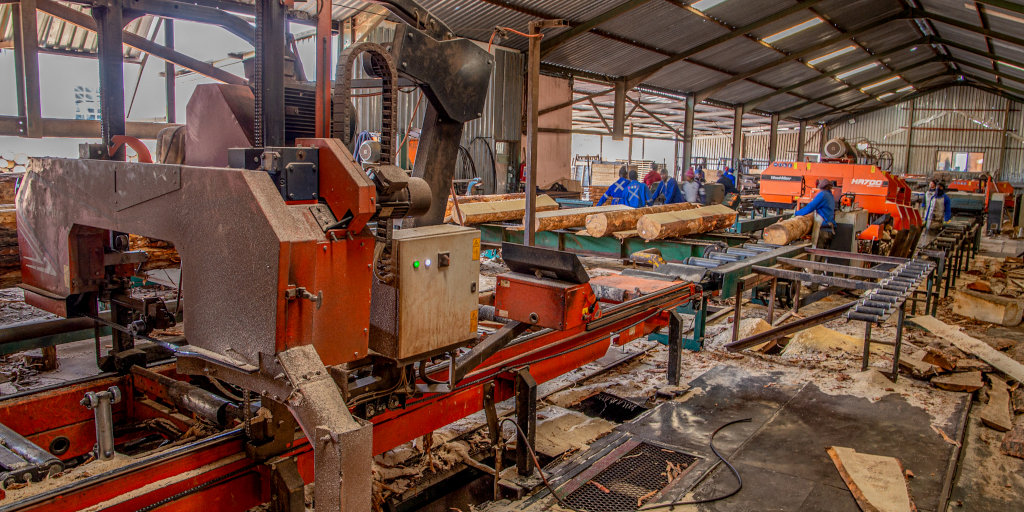Part of the Wood-Mizer line at New Heights Sawmill.
Press Office: Wood-Mizer
The southern slopes of the Drakensberg or Dragon Mountain range in the Eastern Cape Province, is home to New Heights Sawmill and a Wood-Mizer sawmill line that governs the mill’s output.
The magnificent Drakensberg Mountain range straddles the eastern side of the southern African escarpment like a giant reclining dragon.
The tail in the Eastern Cape, the body in KwaZulu-Natal also called Ukhahlamba or Barrier of Spears in Zulu, and the head 1,000 kilometers away in the Limpopo Province, draws a wide divide across South Africa.
It’s in the shadow of the dragon that New Heights Sawmill near Elliott in the Eastern Cape lies.
The farm and sawmill that both trades as New Heights is evidence of John and Fiona Schenk’s abiding romance with the soil, nature and timber.
John’s father and uncle were already milling timber in the 1950s near Alice, some 350 kms southwest of Khowa (Elliott) where New Heights Sawmill is based.
“My Dad, who owned a trading store in Alice, milled timber with portable mills. He regularly spoke about trees that were 1.5m in diameter,” John Schenk says, speaking fondly about his Dad.
The Schenk clan’s continuing involvement with timber remains true in 2024.
Schenk Enterprises, a vertically integrated timber processing group with wide interests across the timber value chain is part of it, and so too New Heights Sawmill.
John’s role as a contractor for Mondi, where he milled fire-damaged logs from the company’s commercial forestry operations in the area, was a stepping-stone towards New Heights Sawmill.
When the contract ended in 2012, John and Fiona used the opportunity to buy land and build a sawmill.
Building the backbone of a sawmill.
“The period between starting the sawmill and where it’s now, was a bumpy one,” says John Schenk.
“Securing a steady log supply into the mill was the first challenge.”
He initially harvested poplar trees from riverine areas to supplement log supplies into the mill. Log supply agreements with commercial tree growers in the area followed next.
Despite ongoing log supply challenges, New Heights now has enough log reserves in place to push out 61m3 of sawn material per day.
Log sizes into the mill includes C and D-Class (Ø260-340+ mm) sizes, with a sprinkling of B-Class logs (Ø190-230 mm).
The capacity needed to produce these volumes also grew over time. Sawmilling equipment from Wood-Mizer now forms the backbone of the operation.

Sawn product enroute to markets across South Africa.
Building volumes with Wood-Mizer
New Heights is remarkable for several reasons.
Although the mill is remote, slick logistics into and out of the mill ensure that logs move in and finished product out without any hitch.
The polished logistics is even more striking when it’s considered that the mill takes in 100 logs per day and moves out 120,000 pallets on a regular basis.
The line configuration at New Heights’ is also unique.
It has two log infeed’s that combine to deliver one and two-face logs to a Wood-Mizer HR700 4-head resaw.
The first infeed takes logs into a Wood-Mizer HR500 single-head resaw to produce one open face, while the second infeed goes to a Wood-Mizer LX450 that squares the log on two sides.
The slabs with wane that exit the resaw then feeds to a Linck multirip to produce blocks and boards with sideboards from each primary breakdown point passing pass through a recovery line that consists of a Wood-MizerEG800 and 2-head resaw.
The bulk of the sawn product goes into New Heights’ pallet manufacturing process, with the rest of the sawn output going to manufacturers in the Western Cape and elsewhere in the country.
Building into the future
70-year-old John Schenk’s eyes light up when he talks about the future.
“Agriculture’s been struggling in the area, but we’ve maintained an even keel despite the challenges by combining timber with agriculture.
“We’re also expanding our drying capacity to enter the lucrative pallet export market,” John says.
Pallets used for export purposes must comply with the stringent phytosanitary requirements of the International Plant Protection Convention (IPPC) of the UN’s Food and Agriculture Organisation.
Heat treated or kiln-dried timber is an important way to control the introduction and spread of pests coming from plants or plant-based products across borders.
“Our aim is to increase our kiln-dried output to 78 m3, and in doing so, we’ll have more opportunity to produce IPPC compliant export pallets that sell for more,” John says proudly.
A final word
The fact that John and Fiona Schenck have built New Heights up to where it’s now without caving into the challenges that they’ve faced, speaks to their can-do-attitude and indominable spirit.
Here’s to the next generation of sawmillers to build on their proudly legacy.

